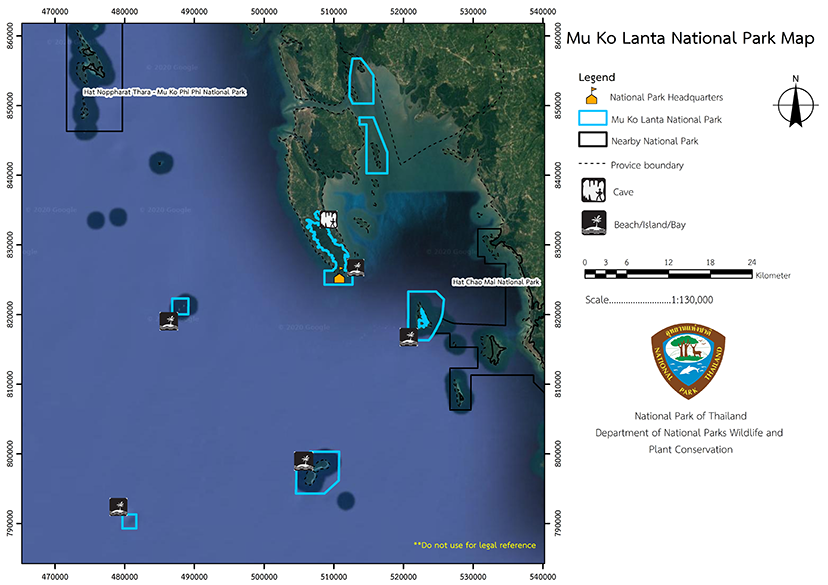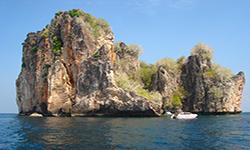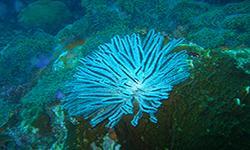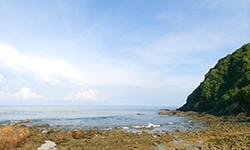Mu Ko Lanta National Park
Contact Location : 59 Moo 5, Ban Laem Tanote, Ko Lanta Yai Sub-distric, Ko Lanta District, Krabi Province 81150
Telephone Number : (+66) 7 565 6576
Email : lantanationalpake@gmail.com
Facebook : Mu Ko Lanta National Park
Information
-
Background
-

Note : After paying the entrance fee to the National Park, please carry the receipt for inspection.

83,750 rai (134 square kilometers)
|
|
|
|
|
|
|
|
|
Nature trails ⇔ Visit Waterfall ⇔ Cave exploration/Geological condition ⇔ Observe flowers/plant ⇔ Bird/Butterfly⇔ Snorkeling ⇔ Scuba diving ⇔ History/Culture
Welfare shop (Restaurant) : Laem Tanot is open daily from 8.30 – 16.30 hrs.
Ko Rok is available daily from 8.30 – 17.00 hrs.
1. Mu Ko Lanta National Park Headquarters Area: AI
- Mu Ko Lanta National Park
2. Ko Rok Area: DTAC, TRUE at some point
- Northside, close to Pak Khlong Phon
3. Area of Ko Tuk Nalima or Ko Ha: AIS
- Southside, close to the Andaman Sea.
4. Ko Ngai Area: AIS, DTAC, TRUE
- Eastside, close to the Andaman Sea
5. Khao Mai Kaeo Waterfall Area: AIS
- West side close to the Andaman Sea
|
|
Mu Ko Lanta National Park is located in Ko Lanta District, Krabi Province, and consists of 25 islands, which can be divided into four groups: the Ko Rok Group, including Ko Rok Nok and Ko Rok Nai, which is in the north of the area has standard terrain was rocky cliffs that are eroded. On the west side of the island is a long ridge, and the landing side of the island is about 2.4 kilometers long. Its highest peak is at 208 meters above sea level. Ko Rok Nok is the same size as Ko Rok Nai and its highest peak is 156 meters abovsea level. There are two wide plains between the gorge and the sea, which are Thalu Beach and Ao Man Sai.The geology of Ko Rok is from the Permian-Carboniferous period which ranges from 345 to 230 million years ago. Ko Ha Group (Ko Tu Kon Li Ma) and Ko Hin Daeng: Ko Ha Group consists of five small islands, which are fairly flat on the two large islands, with the three smaller islands having rocky outcropps. The geological features of this group of islands are limestone in the Ratchburi Group, from the lower-middle Permian period, which has an age range of 280–230 million years ago.The Ko Ngai Group consists of Ko Ngai and Ko Ma. The east of Ko Ngai has a long sandy beach, and to the south is a bay. Steep hills characterize the northwest side, with the highest peak at 198 meters above sea level. Ko Ma looks like an outcrop without any plain area, and the overall geological conditions of this group are similar to those of Ko Rok. The Ko Lanta Group consists of 16 large and small islands, such as Ko Lanta Yai, Ko Talabeng, and Ko Mai Ngam. The topography of Ko Lanta Yai is complex mountain landscape with gradients of 35 to 50 percent in the central area and peaks ranging from 100 meters sea levelto the highest peak at 488 meters above sea level. There are plains to the south, but on other islands, there is only steep rocky areas without any flatland. The geography of Ko Mai Ngam and Ko Mai Ngam Tai occurs from alluvial and estuarine sediments laid down in wetlands of the Holocene period. The geology of Ko Ra Pu Phang, Ko La Pule, and Ko Talabeng is similar to the Ko Ha Group, with Ko Lanta Yai being similar to the Ko Rok Group. Ko Lanta Yai has many streams that flow except in the dry season, with only three streams flowing all year round, namely the Khlong Chak Stream, the Khlong Nam Chuet Stream, and the Khlong Nin Stream. |
|
The Institute of Climate Information Education located at the weather station near the National Park, found that the average temperature throughout the year is 28 degrees Celsius, with the highest average temperature of 34 degrees Celsius in March. The lowest average temperature was 24 degrees Celsius in December. The average annual rainfall is more than 2,100 millimeters, and in falls mainly in the rainy season, which is influenced by the southwest monsoon. A trip to the Mu Ko Lanta National Park during this period is not safe for visitors, so please follow the opening of the annual tourism season for Mu Ko Rok, Kong Hin Daeng, and Kong Hin Muang, as follows: - Close tourist season from May 16 to November 15 every year. - Open tourist season from November 16 to May 15 of every year
|
|
|
|
Forest resources are abundant, and there is a great diversity of plant species. which can be classified as follows: Tropical Rain Forest (19.42 square kilometers) is on Ko Lanta Yai along Lan Ta Mountain range, which covers almost all of the territory of the National Park. The high canopy and understory layer has an average height of 15–25 meters. The important plants are Shorea henryana., Dipterocarpus turbinatus C.F.Gaertn., Lagerstroemia floribunda Jack, and Hopea ferrea Laness. On the ground floor, there is Licuala paludosa Griff, Calamus viminalis Willd., Calamus caesius Blume and Calamus peregrinus Mangrove swamp forests surround the small islands of Ko Mai Ngam, Ko Mai Ngam Tai, and Ko Ngu. Most of the plants are similar in height, with a maximum height of 5 meters. Typically, the plants found are Avicennia alba Blume, Rhizophora apiculata, and Rhizophora mucronata. The beach forest is found in a small area between the boundary of the beach and the tropical rain forest of Ko Ngai housing important plants such as Terminalia catappa, Derris indica (Lamk.) Benn., Goat's Foot creeper, and Seashore Screwpine. Wildlife is grouped into six major categories: mammals from 20 families, 30 genera, and 38 species. The two species have already disappeared from Ko Lanta, which are Sambar and Bengal Tiger. Dugong are protected species. The two species that are likely to disappear are Muntjac and Fishing Cats Marshall's Horseshoe Bat is a rare species there. There are a total of 58 families of birds, with 130 genera, and 185 species. Birds commonly found in the National Park include the Brahminy Kite (Haliastur indus), , Bridled Tern, and Grey-Capped Emerald Dove. Rare birds include the Orange-Breasted Trogon, Siberian Thrush, and Little Spiderhunter. Reptile species that are common include the Flat-Tailed House Gecko, Common Water Monitor, Reticulated Python, and Indo-Chinese Rat Snake. There are only a small number of amphibians, which are the Malayan Giant Frog and the Ornate Narrow-Mouthed Frog. The Northern Tree Frog and the Indochinese Dwarf Toad can be found around the buildings and water sources in the forest, and arare species found in the park is the Doria Frog. Freshwater and marine fish can be found such as the Pearl Danio, Dwarf Snakehead, and Puntius aurotaeniatus. Marine fish can be found in the coral reefs, on the Hin Beach shore, and in the mouth of Namchuet Canal. These include Freshwater Garfish, Lizard Fish, Porcupine Fish, and Balloon FishCoral reef animals include Plerogyra sinuosa (Dana, 1846), Staghorn Coral, Mushroom Coral, and anemone-like coral (Goniopora spp.), Diploastrea heliopora . |
How to get there by car :
Mu Ko Lanta National Park (Laem Tanot) takes approximately 850 kilometers from Bangkok. Take Highway No. 4 to Krabi and then Trang section, which is another milestone no. 64, and then turn right onto Highway No. 4206 to Ban Hua Hin. Then you must take two car ferries, first to Ko Lanta Noi and then to Ko Lanta Yai, respectively. Some routes on the islands are are steep and may require a 4WD vehicle.
How to get there by boat
From Krabi to Ko Lanta, visitors board at the following ports:
The ferry departs from Khlong Chi Lat Pier, Mueang District, Krabi Province, at 11.00 hrs. and arrives at Ko Lanta at about 13.00 hrs. The fare is about 350 baht. Alternatively, at Ao Ton Sai Pier (Ko Phi Phi), the ferry departs at at 8.00 hrs. and arrives in Ko Lanta at about 9.30 hrs., and the fare is about 300 baht.
How to get there by
Bus travels from Bangkok to Krabi from Sai Tai Mai (Borommaratchachonnani). You can either travel on a regular bus or VIP buses with fares ranging from 614 to 920 baht.
- National Park Ranger Station Lo To No. 1 (Ko Rok)
- National Park Ranger Station Lo To No. 2 (Ko Ngai)
- National Park Ranger Station Lo To No. 3 (Khlong Sai)
- National Park Ranger Station Lo To No. 4 (Khlong Mai Kaeo)
Accommodation : Lanta 202/1 (Cha Pi Nai)
Lanta 202/2 (Cha Pi Nai)
Lanta 203/1 (Bin La)
Lanta 203/2 (Bin La)
Lanta 204/1 (Karok)
Lanta 204/2 (Karok)
Lanta 205/1 (Pu Kai)
Lanta 205/2 (Pu Kai)
Lanta 206/1 (Men Thale)
Lanta 206/2 (Men Thale)
Mu Ko Lanta National Park offers accommodation in both lodges and camping grounds and has a tent and other equipment rental service There is also a restaurant available.






